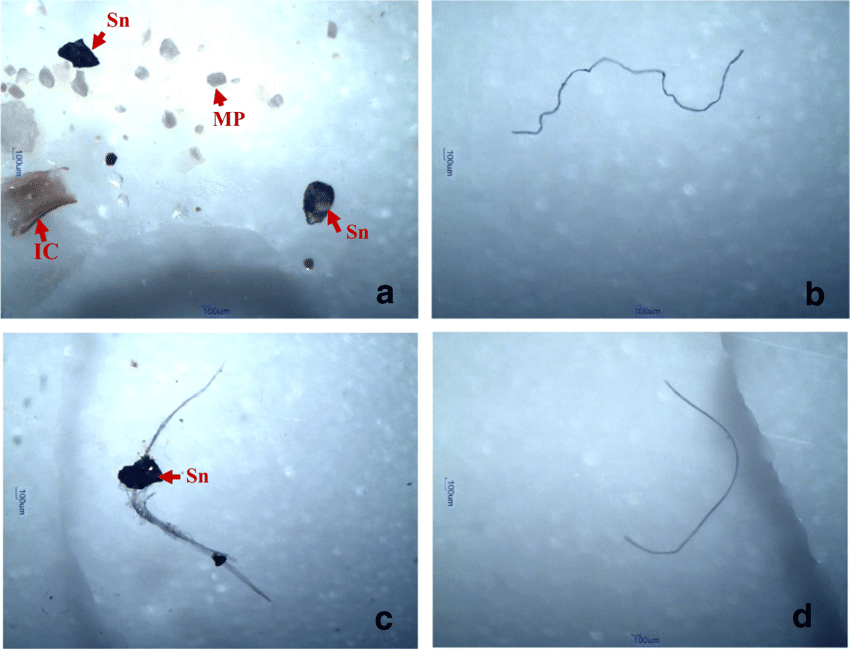Microplastic forms under the stereo microscope observation with 10 × 4 magnification: (a) granule plastic debris (plastic-type had not been identified); (b) filament (assumed as polyester or PE); (c) unclear fragment (assumed as polyethylene or PET); and d nylon (NY). The symbol letter pointed by red arrows is sand grain (Sn), insect carapace (IC), and microplastic (MP)
Source: https://link.springer.com/article/10.1007/s11270-021-05142-y
Stereo microscopy identification is the first fast- screening method for identifying microplastics based on its shape, size, and color. Stereoscopic microscope is simple, fast, inexpensive and high portability making it famous tool for microplastic analysis. Magnified images using stereoscopic microscope provide detailed surface texture and structural information of the objects that are essential for identifying ambiguous, plastic-like particles but it is limited to the size of >1mm. (1) Stereoscopic microscope can be used for three-dimension examination, observing the samples from two to some extent different angles for stereoscopic vision, because the illumination system of stereoscopic microscopes comes from the above as conversely to the optical microscope.
Prior to stereo microscopy identification, the microplastic from tertiary or aquatic environment are filtered using filter paper and dried at 60°C. To aid in the analysis of the sample, visual references, such as pre-printed black gratings, can be used. (2) Under the stereoscopic microscope, microplastics were categorized into four types (fragment, fiber, sheet and expanded polystyrene (EPS). (3) It should be noted that the observation using stereoscopic microscope for biogenic materials from sediment and neuston net samples that have not been completely eliminated by chemical digestion is difficult. (1) Previous studies have shown that false identification of plastic-like particles using the stereo microscopy method was often over 20% and it is more than 70% for transparent particles. Therefore, additional analytical method such as Fourier Transform Infrared Spectroscopy (FTIR) or Ramen Spectroscopy may be needed to further confirm the presence of microplastics and to identify their chemical composition.
Ref
- W. J. Shim et al, (2013) , “Identification methods in microplastic analysis: a review” , This journal of The Royal Society of Chemistry 2, 00, 1-3
- J. Caldwell et al., 2022, “ The micro-, submicron-, and nanoplastic hunt: A review of detection methods for plastic particles”, Chemosphere 293,133514
- Song YK, Hong SH, Jang M et al (2015) “A comparison of Microscopic and spectroscopic identification for analysis of microplastics in environmental samples”. Mar Poll Bull 93:202–209.
By: Moe Thazin Shwe, SOLEN Research Associate – IPC panel member
Editted by: Hendra WINASTU, SOLEN Principal Associate – IPC panel coordinator
Date: 28 February 2023
Article#: SOLEN-IPC-0011



 Tiếng Việt
Tiếng Việt 日本語
日本語
Pingback: Identification of microplastics using Raman Spectroscopy - Solen
Pingback: Analytical methods for microplastics - SOLEN-IPC-010 - Solen